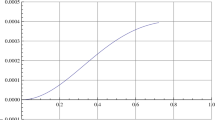Abstract
It was shown recently that associated with a pair of real sequences \(\{\{c_{n}\}_{n=1}^{\infty }, \{d_{n}\}_{n=1}^{\infty }\}\), with \(\{d_{n}\}_{n=1}^{\infty }\) a positive chain sequence, there exists a unique nontrivial probability measure \(\mu \) on the unit circle. The Verblunsky coefficients \(\{\alpha _{n}\}_{n=0}^{\infty }\) associated with the orthogonal polynomials with respect to \(\mu \) are given by the relation
where \(\tau _0 = 1\), \(\tau _{n}=\prod _{k=1}^{n}(1-ic_{k})/(1+ic_{k})\), \(n \ge 1\) and \(\{m_{n}\}_{n=0}^{\infty }\) is the minimal parameter sequence of \(\{d_{n}\}_{n=1}^{\infty }\). In this manuscript, we consider this relation and its consequences by imposing some restrictions of sign and periodicity on the sequences \(\{c_{n}\}_{n=1}^{\infty }\) and \(\{m_{n}\}_{n=1}^{\infty }\). When the sequence \( \{c_{n}\}_{n=1}^{\infty }\) is of alternating sign, we use information about the zeros of associated para-orthogonal polynomials to show that there is a gap in the support of the measure in the neighbourhood of \(z= -1\). Furthermore, we show that it is possible to generate periodic Verblunsky coefficients by choosing periodic sequences \(\{c_{n}\}_{n=1}^{\infty }\) and \(\{m_{n}\}_{n=1}^{\infty }\) with the additional restriction \(c_{2n}=-c_{2n-1}, \, n\ge 1.\) We also give some results on periodic Verblunsky coefficients from the point of view of positive chain sequences. An example is provided to illustrate the results obtained.






Similar content being viewed by others
References
Bracciali CF, McCabe JH, Peréz TE, Sri Ranga A (2016) A class of orthogonal functions given by a three term recurrence formula. Math Comput 85:1837–1859
Breuer J, Ryckman E, Simon B (2010) Equality of the spectral and dynamical definitions of reflection. Commun Math Phys 295:531–550
Castillo K, Costa MS, Sri Ranga A, Veronese DO (2014) A Favard type theorem for orthogonal polynomials on the unit circle from a three term recurrence formula. J Approx Theory 184:146–162
Castillo K, Garza L, Marcellán F (2011) Perturbations on the subdiagonals of Toeplitz matrices. Linear Algebra Appl 434:1563–1579
Chihara TS (1978) An introduction to orthogonal polynomials. Gordon and Breach, New York
Costa MS, Felix HM, Sri Ranga A (2013) Orthogonal polynomials on the unit circle and chain sequences. J Approx Theory 173:14–32
Costa MS, Godoy E, Lamblém RL, Sri Ranga A (2011) Basic hypergeometric functions and orthogonal Laurent polynomials. Proc Am Math Soc 140:2075–2089
Dimitrov DK, Sri Ranga A (2013) Zeros of a family of hypergeometric para-orthogonal polynomials on the unit circle. Math Nachr 286:1778–1791
Erdélyi T, Nevai P, Zhang J, Geronimo J (1991) A simple proof of “Favard’s theorem” on the unit circle. Atti Semin Mat Fis Univ Modena Reggio Emilia 39:551–556
Geronimus Ya L (1944) On polynomials orthogonal on the unit circle, on trigonometric moment problem, and on allied Carathéodory and Schur functions. Mat Sb 15:99–130
Ismail MEH (2005) Classical and quantum orthogonal polynomials in one variable. In: Encyclopedia of mathematics and its applications, vol 98. Cambridge University Press, Cambridge
Kheifets A, Golinskii L, Peherstorfer F, Yuditskii P (2011) Scattering theory for CMV matrices: uniqueness, Helson-Szegő and strong Szegő theorems. Integral Equ Oper Theory 69:479–508
Peherstorfer F (2011) Positive trigonometric quadrature formulas and quadrature on the unit circle. Math Comput 80:1685–1701
Peherstorfer F, Steinbauer R (1996) Orthogonal polynomials on arcs of the unit circle, I. J Approx Theory 85:140–184
Peherstorfer F, Steinbauer R (1996) Orthogonal polynomials on arcs of the unit circle, II. Orthogonal polynomials with periodic reflection coefficients. J Approx Theory 87:60–112
Peherstorfer F, Volberg A, Yuditskii P (2009) CMV matrices with asymptotically constant coefficients. Szegő-Blaschke class, scattering theory. J Funct Anal 256:2157–2210
Simanek B (2012) Week convergence of CD kernels: a new approach on the circle and real line. J Approx Theory 164:204–209
Simon B (2005) Orthogonal polynomials on the unit circle. Part 1. Classical theory. In: American Mathematical Society Colloquium Publications, vol 54. American Mathematical Society, Providence, RI
Simon B (2005) Orthogonal polynomials on the unit circle. Part 2. Spectral theory. In: American Mathematical Society Colloquium Publications, vol 54. American Mathematical Society, Providence, RI
Szegő G (1975) Orthogonal polynomials. In: American Mathematical Society Colloquium Publications, vol 23, 4th edn. American Mathematical Society, Providence, RI
Tsujimoto S, Zhedanov A (2009) Elliptic hypergeometric Laurent biorthogonal polynomials with a dense point spectrum on the unit circle. SIGMA Symmetry Integrability Geom Methods Appl 5:30
Wall HS (1948) Analytic theory of continued fractions. D. Van Nostrand Company, New York
Author information
Authors and Affiliations
Corresponding author
Additional information
Communicated by Antonio José Silva Neto.
C. F. Bracciali and A. S. Ranga were supported by funds from FAPESP (2014/22571-2) and CNPq (475502/2013-2, 305073/2014-1, 305208/2015-2) of Brazil. J. S. Silva and D. O. Veronese were supported by grants from CAPES of Brazil.
Rights and permissions
About this article
Cite this article
Bracciali, C.F., Silva, J.S., Sri Ranga, A. et al. Orthogonal polynomials on the unit circle: Verblunsky coefficients with some restrictions imposed on a pair of related real sequences. Comp. Appl. Math. 37, 1142–1161 (2018). https://doi.org/10.1007/s40314-016-0392-y
Received:
Accepted:
Published:
Issue Date:
DOI: https://doi.org/10.1007/s40314-016-0392-y
Keywords
- Para-orthogonal polynomials
- Probability measures
- Periodic Verblunsky coefficients
- Chain sequences
- Alternating sign sequences



